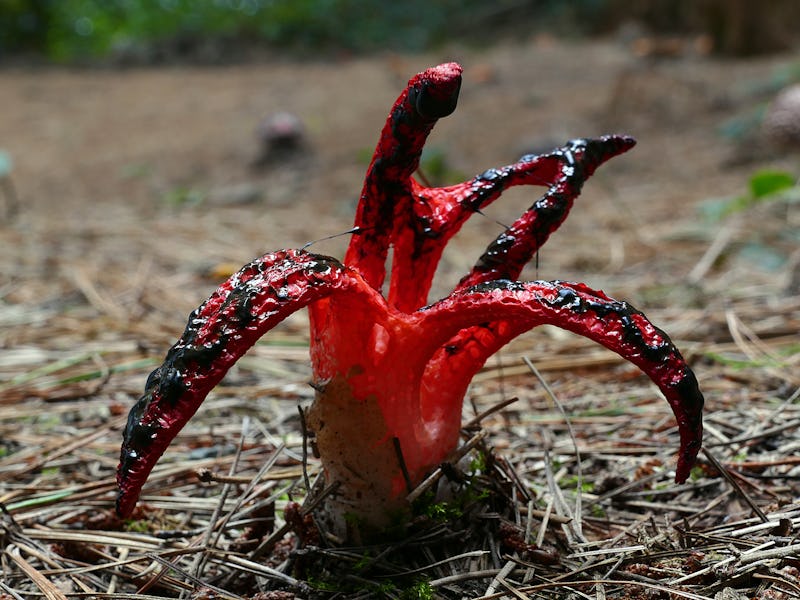"Devil's Fingers" Fungus Proves That Life Sometimes Has to Smell Like Death
"The fungus is pretty smart."

You can’t blame home gardeners for freaking out when they see the Devil’s Fingers, sprouting from the mulch like a literal red right hand slick with putrid black goo. Recently, a photo of the frightening fungus, technically called Clathrus archeri, made it to the top of Reddit’s r/WTF page, where users gawked at its Alien-like appearance.
But not everyone reacts to the fungus with such disdain. To mycologist Andrew N. Miller, Ph.D. of the Illinois Natural History Survey, the fungus is a paradigm of smart evolution.
“Some people like flowers. Some like fungi,” he tells Inverse. C. archeri, known also as the “octopus stinkhorn,” is no rose, but its bright red arms, which burst through its white “egg” with an alarming pop, have a certain grotesque beauty to them. Even the black slime on its tentacles, home to all of its spores, has the same shimmering slickness as an oil spill. Its eye-watering odor, likened to the sharp smell of rotting meat, is a harder sell, but Miller says even its nostril-singeing stench plays an important evolutionary purpose.
C. archeri looks like alien tentacles sprouting from an egg. It smells even worse than it looks.
The fungus, which has spread along America’s coasts since arriving here around the ‘80s, is a saprophyte — an organism that lives off dead or decaying matter — and is part of a family of bad-smelling funguses known as the stinkhorns. These are so named because they reek of death, which, to some flies, is the smell of dinner.
“What it does is attract insects, especially flies,” he says. “Flies come to the top of the stinkhorn and they eat that mucus. They’re basically not only eating spores — they’re getting spores all over their wings and feet, then the fly flies off and disperses the spores for the fungus.”
“The fungus,” he says, “is pretty smart.”
C. archeri, then, comes from a family of geniuses. The other stinkhorns, says Miller, generally all use the same strategy to spread its spores.
“It’s a really cool relationship, when you think about it,” he explains. “These things germinate from a little egg-like structure, then they pop up within a day or two. But they have all of their spores at the top of these tentacles.”
While. C. archeri is a bit of an intruder — it’s usually found in South Africa, Madagascar, New Zealand, and parts of Europe and Latin America — it’s got stinkhorn relatives here. Miller, who lives in Illinois, commonly runs into C. archeri’s crudely nicknamed cousin.
“It’s called the ‘dog dick stinkhorn’,” he says. “I’ll just let your imagination figure out what it looks like. Basically it looks like a dog penis, and at the very top, it’s got a brown gel all over it.” Suddenly, it makes sense that the Latin name for the stinkhorn family is Phallaceae.
The 'dog dick stinkhorn': Better looks, worse nickname.
Miller makes a convincing case for why C. archeri and its phallic cousins should be revered, not reviled, but not everyone can be convinced. Some removal guides suggest kicking them; others smashing them with a shovel. They are, admittedly, frightening things to see and smell among the roses, but if you ever see their long scarlet fingers beckoning to you from the rot and the mulch, give them a closer look, and maybe you’ll see what Miller sees.
“It’s better than a flower,” he laughs.